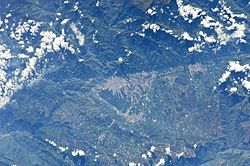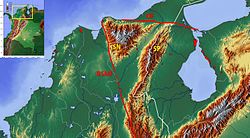| Bucaramanga-Santa Marta Fault | |
|---|---|
| Bucaramanga-Santa Marta Fault System (Sistema de) Falla(s) de Bucaramanga-Santa Marta | |
 View of the Bucaramanga Fault along Bucaramanga | |
 Topographic map of northern Colombia showing the fault | |
| Etymology | Bucaramanga, Santa Marta |
| Coordinates | 7°05′25″N 73°05′15″W / 7.09028°N 73.08750°W |
| Country | Colombia |
| Region | Caribbean, Andean |
| State | Magdalena, Cesar, Norte de Santander, Santander |
| Cities | Santa Marta, El Paso, Bucaramanga, Floridablanca, Piedecuesta |
| Characteristics | |
| Elevation | 1–1,500 m (3.3–4,921.3 ft) |
| Range | Sierra Nevada de Santa Marta Eastern Ranges Andes |
| Part of | Andean faults |
| Segments | Santa Marta, Algarrobo, Bucaramanga Faults |
| Length | 674 km (419 mi) |
| Strike | 341 ± 23 (NNW-SSE) |
| Displacement | 110 km (68 mi) |
| Tectonics | |
| Plate | South American Plate |
| Status | Active |
| Earthquakes | Pre-Columbian era (~1020 AD) |
| Type | Strike-slip fault |
| Movement | Sinistral |
| Rock units | Caribbean, La Guajira, Tahamí & Chibcha Terranes |
| Age | Neogene-Holocene |
| Orogeny | Andean |
The Bucaramanga-Santa Marta Fault (BSMF, BSF) or Bucaramanga-Santa Marta Fault System (Spanish: (Sistema de) Falla(s) de Bucaramanga-Santa Marta) is a major oblique transpressional sinistral strike-slip fault (wrench fault) in the departments of Magdalena, Cesar, Norte de Santander and Santander in northern Colombia. The fault system is composed of two main outcropping segments, named Santa Marta and Bucaramanga Faults, and an intermediate Algarrobo Fault segment in the subsurface. The system has a total length of 674 kilometres (419 mi) and runs along an average north-northwest to south-southeast strike of 341 ± 23 from the Caribbean coast west of Santa Marta to the northern area of the Eastern Ranges of the Colombian Andes.
The fault system is a major bounding fault for various sedimentary basins and igneous and metamorphic complexes. The northern Santa Marta Fault segment separates the Sinú-San Jacinto Basin and Lower Magdalena Valley in the west from the Sierra Nevada de Santa Marta to the east. The buried Algarrobo Fault segment forms the boundary between the Lower Magdalena Valley and northern Middle Magdalena Valley to the west and the Cesar-Ranchería Basin in the east. The Bucaramanga Fault segment separates the middle part of the Middle Magdalena Valley in the west from the Santander Massif in the east.
The fault system bounds and cuts the four largest terranes of the North Andes Plate; the La Guajira, Caribbean and Tahamí Terranes along the Santa Marta section and intraterrane movement in the Andean Chibcha Terrane. Studies of the fault segments have shown the fault was active in the pre-Columbian era, around the year 1020, when the area around Bucaramanga was inhabited by the Guane. Various seismic events analysed to have occurred during the Holocene of the Bucaramanga Fault segment lead to the conclusion the fault is active.

